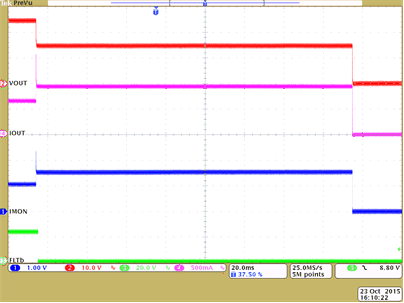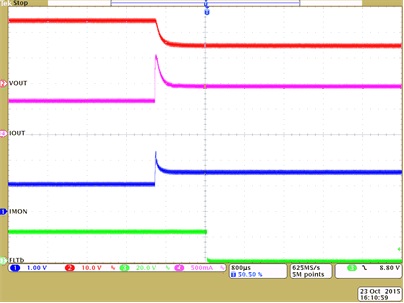ZHCSFF5G July 2016 – December 2019 TPS2660
PRODUCTION DATA.
- 1 特性
- 2 应用
- 3 说明
- 4 修订历史记录
- 5 Device Comparison Table
- 6 Pin Configuration and Functions
- 7 Specifications
- 8 Parameter Measurement Information
-
9 Detailed Description
- 9.1 Overview
- 9.2 Functional Block Diagram
- 9.3
Feature Description
- 9.3.1 Undervoltage Lockout (UVLO)
- 9.3.2 Overvoltage Protection (OVP)
- 9.3.3 Reverse Input Supply Protection
- 9.3.4 Hot Plug-In and In-Rush Current Control
- 9.3.5 Overload and Short Circuit Protection
- 9.4 Device Functional Modes
-
10Application and Implementation
- 10.1 Application Information
- 10.2
Typical Application
- 10.2.1 Design Requirements
- 10.2.2 Detailed Design Procedure
- 10.2.3 Application Curves
- 10.3 System Examples
- 10.4 Do's and Don'ts
- 11Power Supply Recommendations
- 12Layout
- 13器件和文档支持
- 14机械、封装和可订购信息
封装选项
请参考 PDF 数据表获取器件具体的封装图。
机械数据 (封装 | 引脚)
- RHF|24
- PWP|16
散热焊盘机械数据 (封装 | 引脚)
- PWP|16
订购信息
9.3.5.3.1 Look Ahead Overload Current Fault Indicator
With the device configured in current limit operation and when the overload condition exists for more than tPGOODF, 875 µs (typical), the FLT asserts to warn of impending turnoff of the internal FETs due to the subsequent thermal shutdown event. Figure 46 and Figure 47 depict this behavior. The FLT signal remains asserted until the fault condition is removed and the device resumes normal operation.

| RILIM = 12 kΩ | MODE pin connected to RTN | Load transient event from 37 Ω to 15 Ω |

| RILIM = 12 kΩ | MODE pin connected to RTN | Load transient event from 37 Ω to 15 Ω |